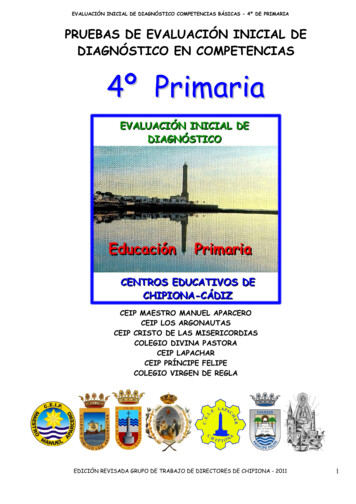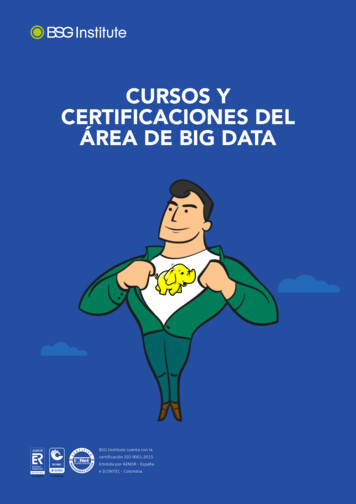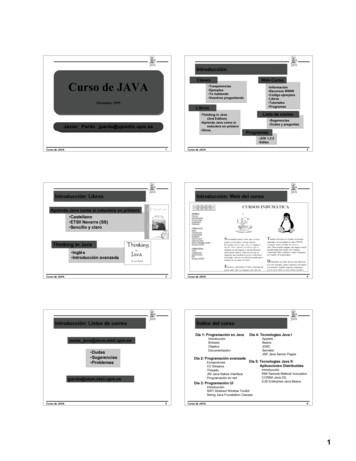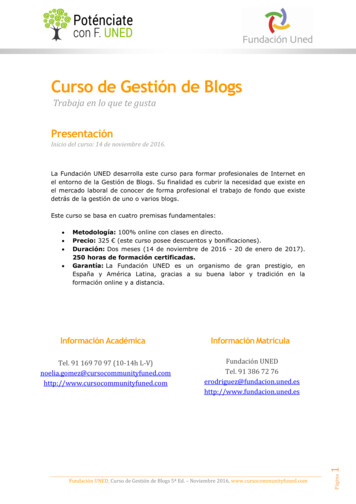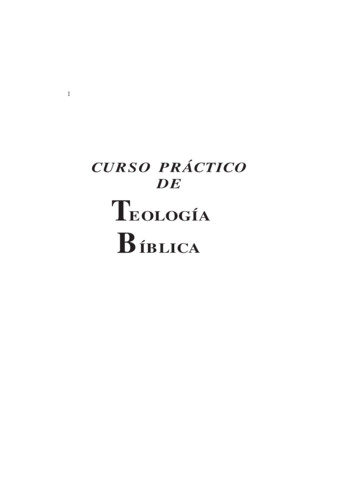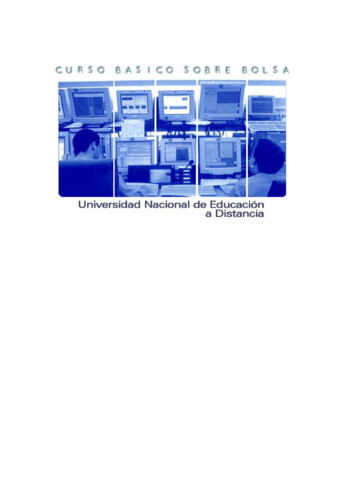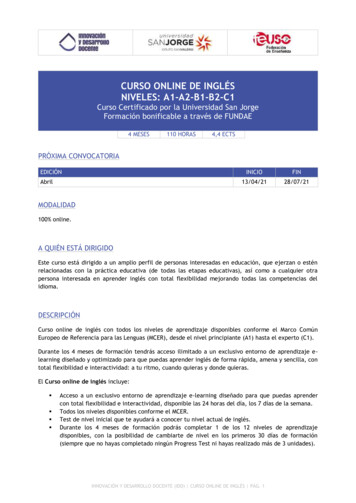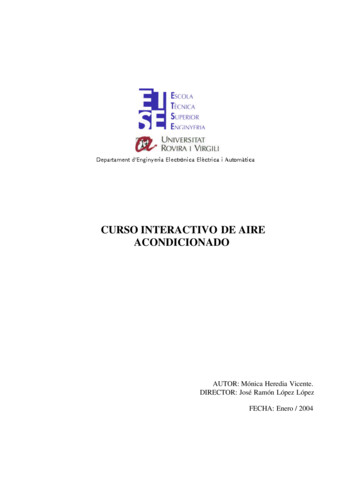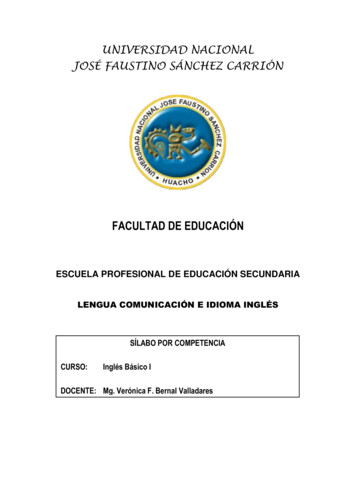
Transcription
UNIVERSIDAD NACIONALJOSÉ FAUSTINO SÁNCHEZ CARRIÓNFACULTAD DE EDUCACIÓNESCUELA PROFESIONAL DE EDUCACIÓN SECUNDARIALENGUA COMUNICACIÓN E IDIOMA INGLÉSSÍLABO POR COMPETENCIACURSO:Inglés Básico IDOCENTE: Mg. Verónica F. Bernal Valladares
SÍLABO DE INGLÉS BÁSICO II.DATOS GENERALESLÍNEA DE CARRERACURSOCÓDIGOHORASCICLOII.CURSOS GENERALESInglés Básico I1521 hora teórica / 2 horas prácticasIISUMILLA Y DESCRIPCIÓN DEL CURSOEl curso Inglés Básico I es de carácter obligatorio y pertenece al área de formaciónbásica general. Su naturaleza es teórico-práctico y su propósito es desarrollarhabilidades comunicativas y lingüísticas propias del idioma como: listening, writing,speaking, reading and grammar, que le permita al estudiante comprender y producirmensajes orales y escritos en situaciones cotidianas.Contenidos:Unit I: Greetings and Farewells. Definite and indefinite article. Subject pronouns. Verb tobe positive statements. Possessive adjective. The English Alphabet. Be: yes/no questionand short answers. Questions with what.Unit II: Questions with where. Questions with Who and How old. Be: Questions withWhat time and When. Preposition of time and place.Unit III: Demonstrative adjectives. Plural nouns. Possessive pronouns. Question withWhose. Possessive “S” There is/are, Imperative, Have/has affirmative statements.Qualifying adjectives. Adverbs very and so.Unit IV: The simple present tense affirmative statements. The simple present tenseyes/no questions.III.CAPACIDAD AL FINALIZAR EL CURSOCAPACIDAD DE LA UNIDAD DIDÁCTICAUNIT IUNIT IIUNIT IIIUNIT IVSelect the forms of the verb tointroduce oneself and introduce afriend.Use the grammar rules correctly toexpress sentences providinginformation about places and time.Use adjectives to describe people,places and thingsUse the Simple present tense todescribe daily activities at homeNOMBRE DE LAUNIDAD DIDÁCTICANew friendsSESIONESPeople and places5-8People, places andthingsDaily life9 - 121-413 - 16
IV.INDICADORES DE CAPACIDAD AL FINALIZAR EL CURSONÚMERO123456789101112131415161718INDICADORES DE CAPACIDAD AL FINALIZAR EL CURSOUse short expressions with Greetings and Farewells in a dialogue.Identify the correct personal pronouns.Difference a/an with things around the classroom.Talk about people and favorite things.Discriminate the Possessive adjective.Identify correct spelling and write each names and things.Use short sentences to ask and answer questions.Talk about what people do.Talk about where people are from.Interview a partner and write about his or her family.Identify the time and date of each events on a calendar.Answer questions, using prepositions of time and place.Identify things around the classroom with plurals and demonstrativeadjectives.Questions and answer about personal ítems.Talk about interesting places in their towns.Describe a friend or a family member using qualifying adjective and adverbsso and very.Express your activities with a schedule.Ask and answer questions about routines.
UNIDAD DIDÁCTICA I: NEW FRIENDSV.DESARROLLO DE LAS CAPACIDADES DIDÁCTICAS:CAPACIDAD DE LA UNIDAD DIDÁCTICA I: Select the forms of the verb to introduce oneself and introduce a NTALACTITUDINALDIDÁCTICA- Greetings and- Use Greetings andShow interest to meet new friends.Farewells.Farewells to meet people.1 - Definite and- Identify when we use a /an.indefinite article.- Identify the correct subjectGroup Work- Subject pronouns.pronouns.Brainstorm.Intended dialoguePresentations2 - Verb to be positive- Express short sentences to Participate with interest to expressstatements.introducing myself say what sentences to introducing myself and Production of textsRole Play- Possessiveyou do and your favoritesay what you do and your favorite34adjective.- The EnglishAlphabet.- Be: yes/no questionand short answers.- Questions with what.things.- Use the English alphabet tospell names and things.- Express sentences to askand answer shortquestions.- Use what to ask whatpeople do.EVIDENCIA DEL CONOCIMIENTOOral interview and written practices.things.Show interest to spell names andthings and answer short questions.Show interest in understanding andspeaking short answer about peopledo.EVALUACIÓN DE LA UNIDAD DIDÁCTICAEVIDENCIA DEL PRODUCTOWriting: Introducing myself to the class.INDICADORES DE LOGRO DE LACAPACIDAD Use short expressions withGreetings and Farewells in adialogue. Difference a/an with things aroundthe classroom. Use the correct personal pronounsin short sentences. Talk about people and favoritethings. DiscriminatethePossessiveadjective. Identify correct spelling and writeeach names and things. Use short sentences to ask andanswer questions in a dialogue. Talk about what people do.EVIDENCIA DEL DESEMPEÑOThe students introduce their own information and afriend.
UNIDAD DIDÁCTICA II: PEOPLE AND PLACESCAPACIDAD DE LA UNIDAD DIDÁCTICA II: Use the grammar rules correctly to express sentences providing information about people and places.CONTENIDOSINDICADORES DE LOGRO DEESTRATEGIAWEEKLA ICA5678- Questions with where.- Ask for and say people’sAppreciates the use ofnationalities.English.- Questions with Who and- Identify family members and giveValue your partners’ interest.How old.their ages.- Be: Questions with What - Talk events on a calendar: day andRespect your classmates’time and Whentime.intervention.- Preposition of time and - Difference prepositions of time andShows interest to useplace.place.prepositions.EVALUACIÓN DE LA UNIDAD DIDÁCTICAEVIDENCIA DEL CONOCIMIENTOEVIDENCIA DEL PRODUCTOOral interview and written practices.Write an article about famous people.Group WorkBrainstorm.Intended dialoguePresentationsProduction of textsRole Play Talk about where people arefrom. Interview a partner and writeabout his or her family. Identify the time and date ofeach events. Answer questions, usingprepositions of time and place.EVIDENCIA DEL DESEMPEÑOAt the end of this second unit, the student is able todistinguish the correct use of BE with questionwords to talk about famous people.
UNIDAD DIDÁCTICA III: PEOPLE, PLACES AND THINGSUNIDAD DIDÁCTICA IV: DAILYLIFECAPACIDAD DE LA UNIDAD DIDÁCTICA III: Use adjectives to describe people, places and things.CONTENIDOSINDICADORES DE LOGRO DE DIMENTALACTITUDINAL- Demonstrative adjectives. Compare opinions about things in your Appreciates the use of Identify things around the5 - Plural nounsclassroom.English language usingclassroom with plurals andgrammar correctly.demonstrative adjectives.- Possessive pronouns.- Use Possessive pronouns, Question Respect your classmates Questions and answer aboutGroup Work6 - Question with Whose.with Whose and Possessive “S” tointervention.personal ítems.Brainstorm.Intended dialogue- Possessive “S”indicate possession.Presentations7 - There is/are, Imperative,- Describe interesting places in theirShows interest to express Production Talk about interesting places inof textsRole Playtowns.information helpful.their towns.8 - Have/hasaffirmative - Describe a friend.Shows interest to learn Describe a friend or a familystatements.- Difference when use have/has got, so new words to increasemember using qualifying adjective- Qualifying adjectives.and very.vocabulary.and adverbs so and very.- Adverbs: very and so.EVALUACIÓN DE LA UNIDAD DIDÁCTICAEVIDENCIA DEL CONOCIMIENTOEVIDENCIA DEL PRODUCTOEVIDENCIA DEL DESEMPEÑOStudents make sentences using grammarWriting activity: describe people,Oral interview and written practices.rules correctly to express sentences providingplace and thing.information about people, places thing.CAPACIDAD DE LA UNIDAD DIDÁCTICA IV: Use the Simple present tense to describe daily activities at home.INDICADORES DE LOGRO DECONTENIDOSESTRATEGIAWEEKLA NALGroupWork5 - The simple present tenseShows interest to learn new Express your activitiesBrainstorm.Describe your daily activities.affirmative statements.verbs.6Intended dialoguewith a schedule.Presentations7 - The simple present tenseTalk about how often you doAppreciates the use of English Ask and answerProduction of textsRole Playyes/no questions.thing.language in the intonation.8questions about routines.EVALUACIÓN DE LA UNIDAD DIDÁCTICAEVIDENCIA DEL CONOCIMIENTOEVIDENCIA DEL PRODUCTOEVIDENCIA DEL DESEMPEÑOStudents make sentences using grammar rulesOral interview and written practices.Writing activity: Write your daily activities.correctly to express your daily activities.
VI.MATERIALES EDUCATIVOS Y OTROS RECURSOS DIDÁCTICOSLos materiales educativos y recursos didácticos que se utilizaran en el desarrollo del presentecurso:1. MEDIOS ESCRITOS Lecturas seleccionadas Diarios de circulación nacional e internacional Separatas, guías de estudio Libros Diccionario Revistas2. MEDIOS VISUALES Y ELECTRÓNICO Equipo de sonido. Materiales audiovisuales: documentales y entrevistas. TV Presentaciones multimedia. CDs - ROM3. MEDIOS INFORMÁTICOS Páginas Web Videoconferencia Correo electrónico Charla electrónica o chat Diapositivas La Pizarra electrónicaVII.EVALUACIÓNUnidadesI, II, III, IVEvidenciasPorcentajePonderación1. De Conocimiento300.3Cuestionario2. De Producto300.3Tabla de escala valorativa3. De Desempeño400.4Tabla de escala valorativa100%1.00TOTALInstrumentosEl promedio de cada unidad será resultante de la siguiente fórmula:PFUD EC (0.30) EP (0.30) ED (0.40)El promedio final de la asignatura se determinará aplicando la siguiente fórmula:PF PUD1 (0.25) PUD2 (0.25) PUD3 (0.25) PUD4 (0.25)
VIII.BIBLIOGRAFÍA Y REFERENCIA WEBUNIDAD I Rost, Michael. Wordl View book 1, Longman.Saslow, Joan. Ascher, Allen. Top Notch. Fundamenal, student book and workbook.Jack, Richards. David, Bohlke. Four Corners 1. Student book.Guía de práctica unidad Nº 1 por la Mg. Verónica Bernal mUNIDAD II Hall, Eugene J. “People Talking“. Diálogos para estudiantes del nivel Básico eIntermedio en Educación Superior. Marks, J English pronunciation in use Cambridge University Press. Pearson Education Longman, Diccionario pocket Inglaterra. Murphy, T. Grammar in use Great Britain, Cambridge University Press. Guía de práctica unidad Nº 2 por la Mg. Verónica Bernal Valladares.UNIDAD III Murphy, Raymond. Grammar in use. Cambridge University Press. Basic I English book.Intermediate English book. Derek Sellen. Grammar World. Reference and Practice for Elementary to IntermediateStudents. Guía de práctica unidad Nº 3 por la Mg. Verónica Bernal Valladares.UNIDAD IV Rost, Michael. Wordl View book 1, Longman.Saslow, Joan. Ascher, Allen. Top Notch. Fundamenal, student book and workbook.Jack, Richards. David, Bohlke. Four Corners 1. Student book.www.wordreference.com.Pearson Education Longman, Diccionario pocket Inglaterra.Guía de práctica unidad Nº 4 por la Mg. Verónica Bernal Valladares.
IX.PROBLEMAS QUE EL ESTUDIANTE RESOLVERÁ AL FINALIZAR EL CURSOMAGNITUD CAUSALOBJETO DEL PROBLEMAACCIÓN MÉTRICA DEVINCULACIÓNCONSECUENCIA MÉTRICAVINCULANTE DE LA ACCIÓN
IV. INDICADORES DE CAPACIDAD AL FINALIZAR EL CURSO NÚMERO INDICADORES DE CAPACIDAD AL FINALIZAR EL CURSO 1 Use short expressions with Greetings and Farewells in a dialogue. 2 Identify the correct personal pronouns. 3 Difference a/an with things around the classroom. 4 Talk about people and favorite things. 5 Discriminate the Possessive adjective. 6 Identify correct spelling and write each .
